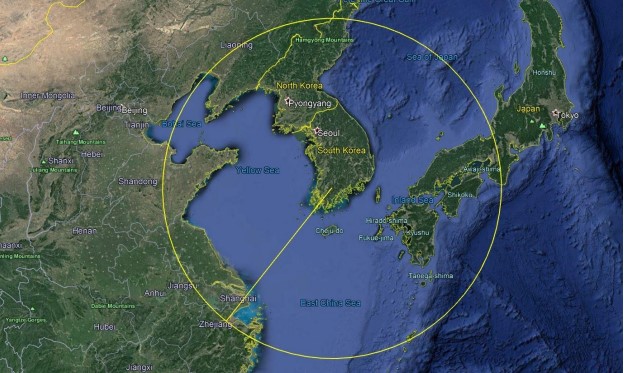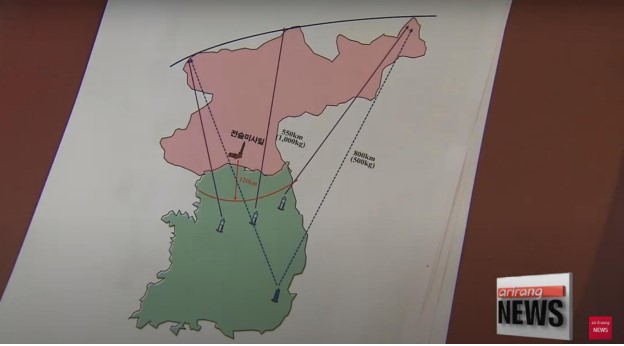
During the State visit of the President of the Republic of Korea (ROK) Moon Jae-in to Washington, D.C. in May 2021, the United States agreed to terminate the 1979 Missile Guidelines. [1]
The 42-year-old guidelines initially limited the range of the ROK's ballistic missiles to 180 km and their payload to no more than 500 kg. The guidelines were revised in 2001 and 2012, allowing the ROK to develop missiles with ranges of 300 km and 800 km respectively. In 2017, the 500 kg cap for ballistic missile payload was also removed.
This brief provides an assessment of the reactions of the People's Republic of China and the Democratic People's Republic of Korea (DPRK) to termination of the missile guidelines.
Assessment of China's Reaction
China's reaction to the termination of the missile guidelines has been modest. Foreign Ministry spokesperson Zhao Lijian only made brief and insubstantial remarks on this issue on 24 May during a regular press briefing (see Attachment 1). In contrast, Zhao provided more lengthy and detailed comments on the US-ROK joint statement and the US-ROK alliance. His comments are summarized below:
1. US-ROK relations should not adversely impact China's interests.
2. The Taiwan question is China's internal affair and should not be included in the US-ROK joint statement; there are no disputes over freedom of navigation and overflight in the South China Sea.
3. The UN-centred international order is the only international order. No countries should create small cliques targeting China. The "Quad" and the "Indo-Pacific strategy" would fail.
Zhao's remarks suggest that China is more concerned about the possibility of a deepened alliance between the ROK and the US.
Chinese media also did not voice particular concern about the termination of the guidelines in their coverage of the summit. Reports from Xinhua News Agency and China News mainly introduced the outcomes of the summit regarding the DPRK policy of the US and the ROK and bilateral cooperation between the US and the ROK. [2] The Global Times [3] and The Paper [4] emphasized the USROK alliance and implied that countries such as the ROK would not be likely to take sides in the US-China strategic competition. [5] While this might be seen as an attempt to downplay the termination of the missile guidelines, in the view of the author of this brief, had that been the case, the media would have made a greater effort to emphasize its unimportance.
The ROK's Defense Ministry spokesperson Boo Seung-chan also stated that there had been no protest by China against the termination of the guidelines. [6] Possible factors for Beijing to be less concerned about the termination of the guidelines could include:
1. Before the termination of the guidelines, the ROK's ballistic missiles were already capable of targeting Shanghai and the Yangtze Delta, which are the most economically developed areas in China (Figure 1).
2. China assesses the threat posed by the ROK ballistic missiles to be very low. In comparison, the deployment of the Terminal High Altitude Area Defense (THAAD) system to the ROK was deemed much more damaging to China's security environment and had already triggered numerous retaliatory actions by China against the ROK.
3. China is more concerned about changing US-ROK alliance dynamics. A deepened US-ROK alliance could result in unfavourable changes in ROK-China trade relations (e.g., the ROK may deepen its integration in the "secure supply chains" [7] of the Biden Administration while reducing its investment and technology transfer to China and hardening its stance on security issues around the Taiwan Strait and the South China Sea).
4. The ROK is fully capable of developing ballistic missiles with a range longer than 800 km. However, a decision to develop such a missile would be based on the ROK's actual or perceived needs, which have yet to clearly materialize. Such a decision would also require careful political calculations.

Figure 1. Before the termination of the missile guidelines, the ROK's ballistic missiles were already capable of targeting Shanghai and the Yangtze Delta region, the most economically developed areas in China, though they could not reach China’s political centre, Beijing. Part of Japan is also within the reach of the ROK's ballistic missiles. Image: Google Earth
Assessment of the DPRK's Reaction
Similarly, the DPRK's public reaction to the termination of the missile guidelines has also not been strong. The state-run Korean Central News Agency (KCNA) only published one article on the subject, which was published under the name of an individual described simply as an "international affairs critic" (see Attachment 2). Judging by the fact that (1) the article was not published under the name of a high-level official or an official organ, and (2) the wording of the article is not as strong and colourful as compared with other articles criticising the US and the ROK published by the DPRK's state media, the protest from the DPRK against the termination of the guidelines could be described as one of form rather than substance.
Possible reasons for this relatively restrained reaction could be that the termination of the guidelines does not substantially change the ROK's threat to the DPRK. This is because, since the easing of the range limit to 800 km in 2012, the ROK's ballistic missiles have already been able to target all of the DPRK. Additionally, the scrapping of the payload weight limit in 2017 allowed the ROK to develop the Hyunmoo-4, a ballistic missile that could target all of the DPRK with a 2 ton warhead. The DPRK took these threats seriously and responded with more vocal criticism [8] and the test firing in late March 2021 of a new type ballistic missile that it claimed to be able to deliver a 2.5 ton warhead over a distance of 600 km. [9]

Figure 2. Hand-out diagram from the ROK military in 2017 showing range of the Hyunmoo-2 ballistic missile, which could target all of the DPRK from the southern areas of the ROK. Image: Arirang News [10]
Attachment 1
Excerpts from China's regular press briefing on 24 May 2021
JoongAng Ilbo: The leaders of the United States and South Korea pledged to strengthen USROK alliance after they met in Washington on May 21. What is China's position on this? When will China have face-to-face summit with other countries? Do you have any plan for that?
Zhao Lijian: We noted the relevant content of the joint statement of the US and the ROK and are concerned about that. We believe that the development of US-ROK relations should be conducive to promoting regional peace, stability, development and prosperity, rather than the opposite, still less harmful to the interests of third parties including China.
The joint statement mentioned issues related to Taiwan and the South China Sea. The Taiwan question is China's internal affair. It bears on China's sovereignty and territorial integrity and allows no interference by external forces. We urge relevant countries to speak and act prudentially on the Taiwan question and refrain from playing with fire. With regard to the South China Sea issue, all countries enjoy the freedom of navigation and overflight in the South China Sea in accordance with international law, and there is no problem with it. Relevant countries know these very clearly.
As to international order, I want to stress that there is only one system in the world, and it is the UN-centered international order; there is only one set of rules, and it is the basic norms governing international relations with the UN Charter as its cornerstone. Neither one nor several countries are entitled to define what the international order is, still less to impose their standard on others. China always opposes relevant countries in creating small cliques targeting other countries including the “Quad” and “Indo-Pacific strategy”. Such unpopular practice will not succeed and will only lead to a dead end.
On your second question, I have no information to offer at this moment.
The Nikkei: The US and ROK presidents on May 21 agreed to end the flight range guidelines that limited ROK missiles to 800 kilometers. What implications will this have on China in terms of security and defence?
Zhao Lijian: China's position on the Korean Peninsula issue is consistent and clear. Under the current circumstances, all parties should make joint efforts to maintain peace and stability on the Peninsula and push forward the political settlement process of the Korean Peninsula issue.
Source: Regular press briefing, 24 May 2021, available at: https://www.fmprc.gov.cn/mfa_eng/xwfw_665399/s2510_665401/t1878214.shtml
Attachment 2
What Is Aim of Termination of "Missile Guidelines"
Pyongyang, May 31, 2021 (KCNA) -- Kim Myong Chol, an international affairs critic, issued the following article titled "What is the aim of the termination of 'missile guidelines'."
The south Korean chief executive during his recent trip to the U.S. announced in a joint press interview that the U.S.-south Korea "missile guidelines" were terminated.
This means a green-light for south Korea to develop missile with all parts of the DPRK and neighboring countries in the striking range, exceeding the 800km maximum range limit.
Already afloat in south Korea and other parts of the world is a disturbing opinion that south Korea can develop even a hypersonic missile, to say nothing of ICBM and SLBM in the shortest possible period.
It is apparently deliberate and hostile act that the U.S. lifted the firing range limit, not content with the removal of the warhead weight limit through the approval of several revised "missile guidelines".
The termination of the "missile guidelines" clearly shows who is behind the escalation of tension on the Korean peninsula.
The U.S., doggedly branding the measures taken by the DPRK for self-defence as violation of UN "resolutions", grants its allies unlimited right to missile development. It is engrossed in confrontation despite its lip-service to dialogue.
The termination step is a stark reminder of the U.S. hostile policy toward the DPRK and its shameful double-dealing.
Lots of countries now view the U.S. key DPRK policy, namely "pragmatic approach" and "maximum flexibility" produced by the Biden administration with much effort as just trickery.
The U.S. act of giving free "missile" rein to south Korea is all meant to spark off arms race on the Korean peninsula and in its surrounding areas and check the development of the DPRK.
The U.S., at the same time, seeks to hold a tighter military grip on south Korea and legitimately realize the deployment of intermediate-range missiles targeting countries around the DPRK in exchange for the termination.
The U.S. is mistaken, however. It is a serious blunder for it to pressurize the DPRK by creating asymmetric imbalance in and around the Korean peninsula as this may lead to the acute and instable situation on the Korean peninsula now technically at war.
The target of the DPRK is not the ROK army but the U.S.
The U.S. calculation to attain its hegemonic purpose with the use of south Korea is a foolish one. A proverb goes sow the wind and reap the whirlwind.
Now that the U.S. and the south Korean authorities made clear their ambition of aggression, they are left with no reasons whatsoever to fault the DPRK bolstering its capabilities for self-defence.
We will counter the U.S. on the principle of strength for strength and good faith in kind. The escalated tension on the Korean peninsula will lead to instability of the forces threatening the DPRK.
We also take this opportunity to make mention of the chief executive of south Korea putting himself within the gun-sights of regional countries, saying it "imparts with glad mind the fact about the termination of missile guidelines".
So disgusting is his indecent act of seeking to sense reactions from this side and that side, with guilty conscience for what it did.
What should deserve concerns of the international community are the U.S. grave and provocative acts against the DPRK just under its nose, not the DPRK's violation of the UN "resolutions" touted by the U.S.
Source: Korean Central News Agency, 31 May 2021
[1] U.S.-ROK Leaders' Joint Statement, White House, 21 May 2021, available at: https://www.whitehouse.gov/briefing-room/statements-releases/2021/05/21/u-s-rokleaders-joint-statement/
[2] Liu Pinran, 美韩领导人表示愿与朝鲜进行外交接触 [US, ROK leaders willing to engage with North Korea], Xinhua News Agency, 22 May 2021, available at: http://www.xinhuanet.com/world/2021-05/22/c_1127478531.htm; 持续长达171分钟 拜登和文在寅首次会晤释放啥信号? [The talk lasted for 171 minutes, what signals are released by the first summit between Moon and Biden?], China News, 22 May 2021, available at: https://www.chinanews.com/gj/2021/05-22/9483011.shtml; Liu Pinran, Xiong Maoling, Xing Yue, 拜登首晤文在寅成果几何? [What are the results of the Biden-Moon summit?], Xinhua News Agency, 22 May 2021, available at: http://www.xinhuanet.com/world/2021-05/22/c_1127479428.htm
[3] Commonly seen as the most nationalist news outlet under the Communist Party's newspaper the People's Daily.
[4] A popular Shanghai-based newspaper under the propaganda department of the Shanghai Municipal Party Committee.
[5] Li Wen, 文在寅称韩美峰会成果超预期,美专家打脸 [Moon says summit beyond expectation, US experts disagree], The Global Times, 24 May 2014, available at: https://news.sina.com.cn/w/2021-05-24/doc-ikmxzfmm4242827.shtml; Chen Qinhan, 文在寅会晤拜登称成果“超预期”, 韩国仍在中美朝之间谨慎游走 [Moon claims summit beyond expectation, ROK still walk cautiously between China and the US], The Paper, 23 May 2021, available at: https://www.thepaper.cn/newsDetail_forward_12812324
[6] 국방부, 미사일지침 해제에 "주변국 영향 고려 결정한 것 아냐" [Ministry of National Defense says that the influence of neighboring countries was not considered in the decision for the termination of the missile guidelines], Yonhap News Agency, 24 May 2021, available at: https://www.yna.co.kr/view/AKR20210524065900504
[7] Executive Order on America's Supply Chains, White House, 24 February 2021, available at: https://www.whitehouse.gov/briefing-room/presidential-actions/2021/02/24/executiveorder-on-americas-supply-chains/
[8] KCNA Commentary Blasts S. Korean Puppet Forces' Intention to Increase Warhead Weight, KCNA, 12 September 2017; Great Programme for Struggle Leading Korean-style Socialist Construction to Fresh Victory - On Report Made by Supreme Leader Kim Jong Un at 8th Congress of WPK, KCNA, 9 January 2021; Vice-Director of Information and Publicity Department of WPK Central Committee Kim Yo Jong Releases Statement, KCNA, 30 March 2021
[9] Academy of Defence Science Test-fires New-type Tactical Guided Missiles, KCNA, 26 March 2021
[10] S. Korea successfully test launches new 800 km-range missile, Arirang News TV, 6 April 2017, available at: https://www.youtube.com/watch?v=5oWzFDnzOwk